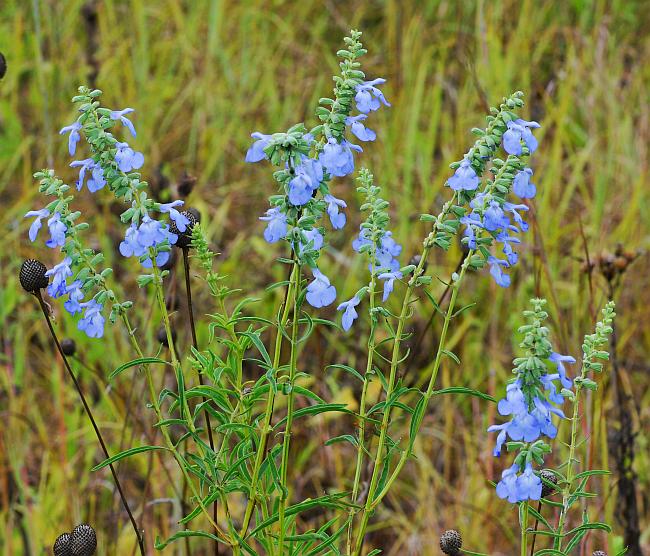Salvia azurea Michx. ex Vahl
Blue Sage

Native
CC = 4
CW = 5
MOC = 38
© SRTurner
Salvia azurea Michx. ex VahlBlue Sage | |
 |
Native CC = 4 CW = 5 MOC = 38 |
© SRTurner |
|
Family - Lamiaceae Habit - Perennial forb with a thick and often woody rootstock. Stems - Ascending to erect, to 1.5 m, 4-angled (the angles rounded), longitudinally keeled, densely pubescent with short, curved hairs, sometimes more sparsely hairy toward the base, sometimes also with scattered, longer, spreading hairs.
Leaves - Opposite. Basal and lower stem leaves usually absent at flowering, short-to long-petiolate, the blade 3-7 cm long, obovate to oblong-obovate or oblanceolate. Stem leaves 3 to numerous pairs, short-petiolate, the blade 2-8 cm long, linear-lanceolate to lanceolate or oblanceolate, tapered at the base, angled to a sharply pointed tip, the margins finely toothed to nearly entire, the upper surface sparsely pubescent with short, curved hairs or nearly glabrous, the undersurface densely pubescent with appressed or curved, somewhat felted, short hairs, also usually with sessile glands.
Inflorescence - Terminal spikes or racemes of whorled flowers (verticillasters), typically with 1-4 flowers per node. Flowers on pedicels to 6 mm long, recurved-pubescent. Bracts usually persistent, 2-8 mm long, narrowly lanceolate to linear.
Flowers - Calyces 4-7 mm long at flowering, becoming elongated to 6-10 mm at fruiting, densely short-hairy, 12-13 nerved, the upper lip entire, the lower lip shallowly 2-lobed. Corollas zygomorphic, bilabiate, 10-25 mm long, the outer surface densely short-hairy, blue, often with pale markings on the lower lip, the tube much longer than the calyx, the upper lip strongly hooded, entire or very shallowly notched at the tip, the lower lip much larger than upper lip, with relatively well-developed lateral lobes and a broadly fan-shaped central lobe, this relatively deeply notched at the tip. Stamens 2, covered by upper lip.
Fruits - Dry schizocarps separating into 4 nutlets, these 2.0-2.8 mm long, the surface brown, smooth or minutely pebbled, sometimes with sessile glands. Flowering - July - September. Habitat - Upland prairies, glades, ledges and tops of bluffs, savannas, upland forest openings, fields, fencerows, railroads, roadsides, open disturbed areas. Also cultivated. Origin - Native to the U.S. Lookalikes - None close, though similar cultivars are sometimes found in gardens. Other info. - This attractive species can be found growing wild in Missouri mainly in the southwestern third of the state. Its main natural range is centered roughly at Missouri's southewestern corner, also extending south into Gulf Coast states. It is cultivated elsewhere. The plant is easily recognized when in flower as nothing else in the state much resembles it. Photographs taken at Schumaker Park, 8-2-00, and in Conecuh National Forest, AL., 10-23-04 (DETenaglia); also at Shaw Nature Reserve, Franklin County, MO, 8-25-2007 and 10-7-2012; Weldon Spring Conservation Area, St. Charles County, MO, 9-25-2012; and near Harrison, AR, 9-6-2024 (SRTurner). |